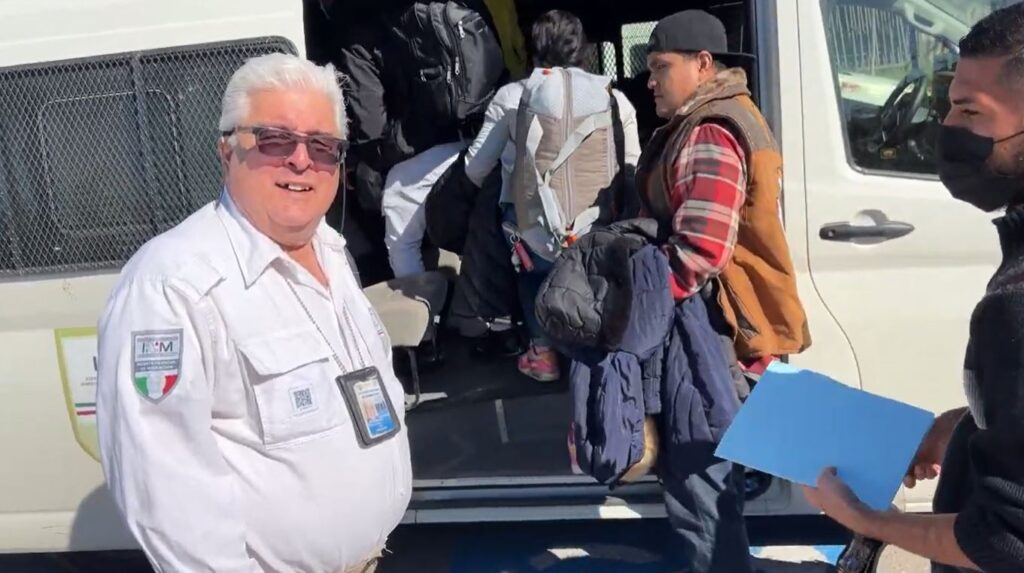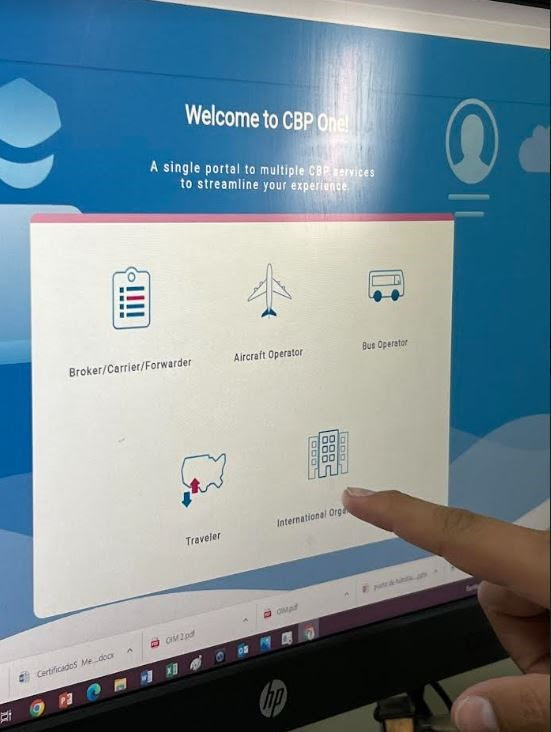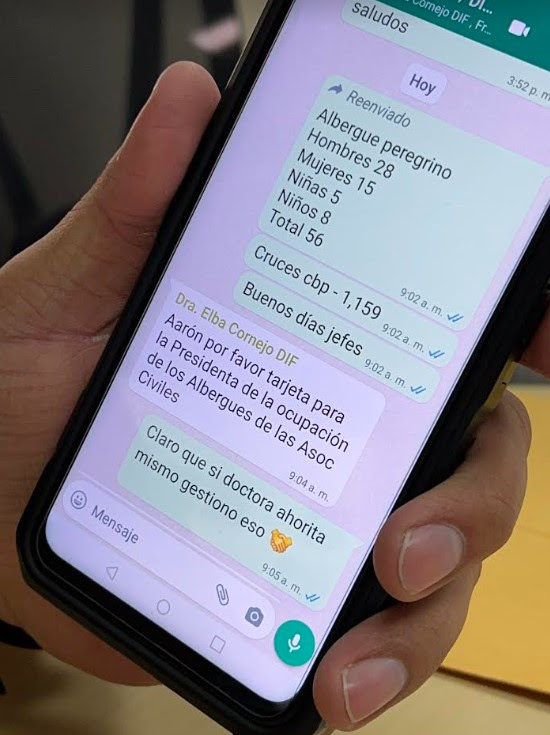CIS gets rare access to a secretive, expanding program that makes border crossing “legal”
By Todd Bensman as published November 21, 2022 for the Center for Immigration Studies
SEE VIDEO REPORT HERE
MEXICALI, Mexico – This northern Mexican city across from California is one of the latest to go live with an unreported, legally questionable new immigration strategy that President Joe Biden’s administration has discretely unfurled for months all along the U.S. southern border.
Twice a day, seven days a week since September, Mexicali city officials working closely with Biden’s U.S. Customs and Border Protection, on a secure shared “CBP-ONE” online platform, select hundreds of immigrants a month for their escorted government-to-government handoffs through the land port of entry to Calexico, Calif.
Once the Americans check their paperwork, they legally admit intending illegal border crossers like Nicaraguan Maria Esperanza Diaz Ruiz, 42, into the U.S. interior under a questionable authority known as “humanitarian or significant public benefit parole.”
They are free to start new lives under the benefit, with work authorization and the right to apply for asylum part of the package.
As she waited with 25 other selected immigrants for her legal ride to America, Maria told the Center for Immigration Studies (CIS) she’d left home figuring she would have to pay smugglers to cross her over the border illegally. But up-trail word from friends reached her down-trail by cell phone that the Biden administration had legally admitted them and many others from Mexicali under the new humanitarian parole program.
They told Maria, “This is real. This is really a real program. This is not a magic trick,” she told CIS.
T
Maria Esperanza Diaz Ruiz of Nicaragua waits at a Mexicali government shelter for imminent transport over the Calexico, Calif., port of entry.
Maria came to Mexicali as soon as she could. A local migrant shelter took her in, and while she was fed and housed in relative security, American volunteers, lawyers, and activists helped her collect the documents America required: just the right documented story of woe, a psychologist attesting to suffered traumas and fear of returning home, proof of citizenship and identity, a clear criminal background, need for urgent free American medical treatment, and a sponsor in the U.S. willing to financially support the applicant. The story Maria proffered is that she worked for a government official in Nicaragua whose homosexuality drew death threats from her ex-husband, also a government worker, against her and her boss.
“I had to leave because I would be killed,” she claimed.
On that claimed basis, Maria was now waiting for a Mexican immigration service bus to drive her and 30 others in her group into America, still unable to believe her unlikely good fortune.
“I am so happy, so, so happy,” Maria said.
Teams of Mexicali city administrators work feverishly to enter each chosen immigrant into the CBP-ONE data portal so the Americans can pre-approve them for handoff at the Calexico border crossing.
After a couple of hours, a Mexican immigration van finally pulled up to the front. A white-uniformed federal officer swung open the van door as the men, women, and children piled in with a few belongings. The bus transported them into a gated section of the port of entry, where they were to be handed over to Americans for processing. CIS was not allowed to follow beyond the gated area.
The CBP-ONE data portal provided to city of Mexicali officials for processing immigrants to the Americans.
The new face of Biden’s border crisis
Indeed, thousands are hearing about this new legal way in – and swamping an expanding system of Mexican shelters that gradually feed their occupants through American ports of entry with temporary legal status and opportunity to make the big move permanent. Local authorities are working to expand shelter facilities and establish new ones to accommodate the soaring demand for the legalized crossings, two shelter managers in Mexicali and one in Tijuana told CIS.
Mexicali city officials recently granted CIS rare, unfettered access to their side of the legalized border-crossing operation that began in September with President Biden’s Department of Homeland Security. Construction on a significant building expansion was underway on acreage behind the shelter.
The Mexicali operation mirrors others just like it that began funneling increasing numbers of immigrants claiming tales of woe into the United States through ports of entry from the Pacific Coast to the Gulf of Mexico, the three shelter managers say. Mexico also appears to have set up operations well south of the American border, in Cancun on Mexico’s southern Caribbean coast and in Monterrey farther north, where pre-approved immigrants are flown into American airports.
This looks to be part of a purposeful strategy to create work-arounds to court-ordered expulsion policies but also to reduce politically painful illegal crossing statistics by channeling ever more people through these legalized crossings. While neither DHS nor the White House has publicized this legalized entrance program,DHS Secretary Alejandro Mayorkas has repeatedly telegraphed it in his oft-stated intentions to create “legal pathways” as part of the administration’s overarching “safe, orderly, and humane” vision for southern border immigration.
“Those who attempt to cross the southern border of the United States illegally will be returned. Those who follow the lawful process … will have the opportunity to travel safely to the United States and become eligible to work here,” Mayorkas said October 13 (Minute 22:01 to 22:17) in reference to the June 2022 signing of the Los Angeles Declaration for Migration and Protection at the Summit for the America’s Conference.
“This advances the Biden administration’s pledge under the Los Angeles Declaration for Migration and Protection to expand legal pathways as an alternative to irregular and dangerous migration.”
Maybe in keeping with the Los Angeles pledge, representatives of Biden’s DHS called Mexicali’s mayor in September 2022 with a “favor” to ask. At the time, hundreds of thousands of people were passing through the region to illegally cross through a gap left in the border wall in Yuma, Ariz., because of President Biden’s order to halt construction. That drew significant media attention two months before the U.S. mid-term elections with races in Arizona mattering for control of the Congress.
Aaron Gomez, a city of Mexicali official recently put in charge of running the Mexican side of the humanitarian parole handoff operation with the Americans.
“They needed to open a new entrance right here, and they needed someone to run it,” said Aaron Gomez, chosen to administer the new government shelter where final departure arrangements are made. “It was a favor the Americans asked for with this program.”
The Americans explained they saw the new Mexicali “entrance” as a way to improve immigrant safety.
“They’re going to cross either way. This will keep them from getting hurt,” Gomez recounted the Americans explaining.
Doling out humanitarian parole to illegal crossers is nothing new to Biden’s DHS; it has already bestowed it upon more than a million people who illegally crossed between ports of entry and presented themselves for the expected reward. The administration continues to hand it out to probably more than 150,000 a month crossing illegally, sending about 35 percent back to Mexico under court-ordered Title 42 or other authorities. (A federal court has ruled that Title 42 must be lifted on December 21, although Remain in Mexico will continue) These are far larger numbers than those escorted in over the ports.
So far, anyway.
But all indications suggest that this new form of legalized border crossing is morphing into a new next phase of Biden’s border crisis, where fewer are illegal but more enter.
Expanding out of public sight and mind
Some scattered media have tangentially reported the Biden administration’s recent application of the escort parole program to Venezuelans and Ukrainians. In August, the news outlet Border Report disclosed that foreign nationals who claimed to be gay found that they could also get the escort from Tijuana to San Diego on humanitarian parole.
But not seen anywhere in the popular media was that DHS was expanding the program all along the rest of the border and also deep inside Mexico, providing a work-around to court-ordered push backs but also an open avenue for people only interested taking advantage of it.
For instance, CBP is taking handoffs of regular Mexican citizens and giving them humanitarian parole. Providing such benefit to Mexicans is extremely rare.
In fact, the majority of the 25 people CIS saw driven to a legal crossing on November 4 were Mexican citizens from the states of Jalisco, Michoacán, and Oaxaca. These men and women staked their applications to a recent spate of cartel violence in Baja and Sonora. But American asylum judges have always uniformly rejected Mexican citizen claims of cartel violence for asylum on grounds that they can find safe haven elsewhere inside Mexico, and Border Patrol routinely pushes back single Mexican men into Mexico under Title 42.
No matter; CBP approved all of these Mexicans because they lived in areas of cartel violence.
Shelter manager Gomez’s phone tallying immigrants he has arranged for hand-off to American immigration officials.
“Right now, I came here because I didn’t want to go home,” explained one young Mexican from Michoacán, where a wave of cartel violence in mid-2022 claimed 800 lives, making it Mexico’s most violent state.
But if cartel violence is rarely, if ever, accepted for humanitarian parole or asylum claims, so too is mere desire for family reunification with loved ones in the United States.
But the hand-off program makes allowances for family reunification, which seemed to be a driving desire among many of those CIS interviewed in Mexicali. Also, the fact that immigrants desiring family reunification had already illegally crossed the southern border and lived for years in the United States did not disqualify them for this program.
For example, one approved Mexican woman from Oaxaca, speaking as city workers entered her information in the CBP-ONE data portal, had illegally crossed the border and also lived illegally in North Carolina for years after.
A Mexican mother of two American children she gave birth to while living illegally in the US is returning with them seeking humanitarian parole for herself to join other U.S. citizen children still in the United States.
The woman, who did not want to be identified, had given birth to twin boys there, making them U.S. citizens and proving her prior illegal presence. But the mother said she returned with the American citizen twins to Mexico seven years ago, when they were toddlers, to rejoin her other non-U.S. citizen children still in Oaxaca. Now, the boys each had fresh U.S. passports and she was using the program to return herself with them so that they can join yet other U.S. citizen children she’d left behind in North Carolina.
That’s a family reunification motive, which is not grounds for humanitarian parole. Yet the woman also was citing cartel violence from the summer for her claim. CBP went for it.
“Now I’m trying to go back and do everything right,” she said.
Also accepted for handoffs were young single men from El Salvador, Honduras, and Nicaragua, and others subjected to court-ordered quick expulsion policies, which the Biden administration has been forced to retain against its will.
Immigrants tell him Tijuana city officials are demanding bribes of $5,000 to $10,000 pesos for them to (BETWEEN $250 AND $500 US DOLLARS) get put on government shelter lists for faster and more guaranteed American crossings.
“That’s the problem that we have. They do it and right away they take you to one of the shelters and in 15 days they’re going to cross you over,” Rivera said. “They say, ‘look, I’ll put you in one of those shelters if you give me so much money. Give me money and then you can cross.”
One immigrant who became a volunteer in the new system started demanding a thousand pesos to “cross you right quick.”
“She got to deposit the money and everything. There’s a whole bunch of problems.”
Were the escort hand-off system continue to expand and become the norm, it would create economic and security incentives for even more to come. First, port escorts eliminate the need to pay thousands of dollars to Mexican cartel smugglers for the right to cross, providing a powerful financial incentive. Second, immigrants allowed in this way avoid criminal dangers in northern Mexico while they wait inside a shelter system that provides for all their daily needs.
The system benefits open-borders advocates and the Biden administration too, pleasing immigration doves in the Democratic Party who demand unimpeded cross-border travel and an end to immigration enforcement. But mainly, the numbers of legal hand-off crossings don’t add to the politically problematic apprehension statistics that worry some Democrats.
After all, technically, this could no longer be called “illegal immigration” if it’s been made “legal.”
And, even better for politicians and immigrants coming up the trail, this kind of entry happens out of sight of news cameras, and therefore remains out of the public mind.
The post Legalized Border Crossing for All: The Next Stage of Biden’s Migration Crisis appeared first on Todd Bensman.
- JOSH HAMMER: Mob Rule Is Taking Over The West - April 2, 2023
- JUDGE ANDREW P. NAPOLITANO: Trump Can Be His Own Worst Enemy - April 2, 2023
- SHOSHANA BRYEN: Here’s What Really Lies Behind The Biden Admin’s Icy Israel Relationship - April 1, 2023
JOIN US @NewRightNetwork on our Telegram, Twitter, Facebook Page and Groups, and other social media for instant news updates!
New Right Network depends on your support as a patriot-ran American news network. Donate now






